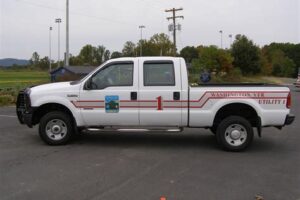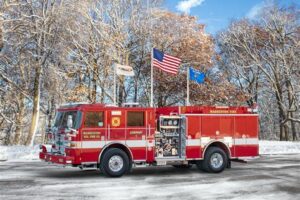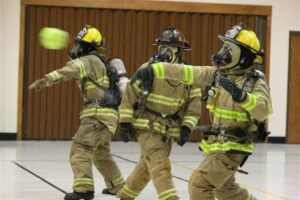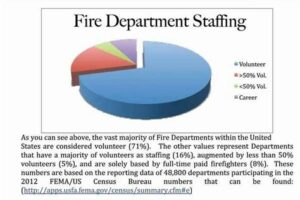Table of Contents
Discover the importance of Volunteer Fire Department Standard Operating Procedures (SOPs). Learn how these guidelines ensure effective emergency response, enhance firefighter safety, and optimize operational efficiency. Explore the key components of SOPs and their role in shaping successful fire service organizations.
When it comes to the safety and well-being of a community, there are few organizations that hold as much importance as the Volunteer Fire Department. These brave men and women selflessly dedicate themselves to protecting lives and property, often risking their own in the process. To ensure efficient and effective operations, the Volunteer Fire Department relies on a set of Standard Operating Procedures (SOPs). These meticulously crafted guidelines serve as the backbone of their operations, allowing them to respond to emergencies with precision, professionalism, and most importantly, the utmost care for those in need.
Introduction
As the backbone of many communities, volunteer fire departments play a crucial role in ensuring the safety and well-being of citizens. These brave men and women dedicate their time and effort to protect lives and property from the devastating effects of fires. One key aspect that enables them to operate efficiently is the development and implementation of Standard Operating Procedures (SOPs). These procedures serve as a guidebook for firefighters, outlining the best practices and protocols to follow in various emergency situations. In this article, we will explore the importance of SOPs for volunteer fire departments and the vital role they play in saving lives.
Establishing a Foundation
The first step in creating effective SOPs for a volunteer fire department is to establish a solid foundation. This involves conducting a thorough risk assessment of the community, identifying potential hazards, and determining the resources available. By understanding the unique challenges faced by their community, fire departments can develop tailored SOPs that address specific needs.
Standardized Training
Training is a critical component of any fire department, and SOPs provide a standardized framework for training programs. These procedures outline the necessary skills, techniques, and knowledge that firefighters must acquire to effectively respond to emergencies. By adhering to standardized training, volunteer fire departments can ensure consistency and increase the overall competency of their personnel.
Emergency Response Protocols
In times of crisis, having clear and concise emergency response protocols is essential. SOPs outline the sequence of actions to be taken during different types of emergencies, such as structure fires, hazardous material incidents, or medical emergencies. By following these protocols, firefighters can minimize confusion and respond swiftly and efficiently to mitigate the situation.
Equipment and Apparatus Guidelines
Proper utilization of firefighting equipment and apparatus is crucial for the safety of both firefighters and those they aim to protect. SOPs provide guidelines on the inspection, maintenance, and operation of equipment, ensuring that it is always in optimal condition. These procedures also outline the appropriate use of various tools and machinery, enhancing overall operational effectiveness.
Establishing Chain of Command
In emergency situations, a clear chain of command is vital to maintain order and facilitate efficient decision-making. SOPs establish an organizational structure within the volunteer fire department, defining roles and responsibilities of officers, incident commanders, and firefighters. This hierarchy ensures effective communication and coordination during emergencies, allowing for quick and effective decision-making.
Risk Management and Safety Procedures
Volunteer firefighters face numerous risks while carrying out their duties. SOPs include safety procedures and risk management protocols to minimize potential hazards and protect personnel. These procedures cover personal protective equipment (PPE) usage, accountability systems, and guidelines for identifying and responding to hazardous conditions. By implementing these measures, volunteer fire departments can prioritize the safety and well-being of their members.
Mutual Aid and Interagency Cooperation
In times of large-scale emergencies or when additional resources are needed, mutual aid and interagency cooperation become crucial. SOPs provide guidelines for requesting and providing mutual aid, facilitating seamless collaboration between different fire departments and emergency response agencies. This cooperation ensures a coordinated response, maximizing efficiency and resources during challenging incidents.
Review and Revision Process
SOPs are not static documents but rather living documents that require regular review and revision. As technologies, best practices, and community needs evolve, SOPs must be updated to reflect these changes. Volunteer fire departments should establish a process for reviewing and revising their SOPs periodically, ensuring they remain relevant and effective in addressing the ever-evolving challenges of firefighting.
Conclusion
Standard Operating Procedures are the backbone of volunteer fire departments, providing essential guidance and structure for firefighters. These procedures enable departments to operate efficiently, respond effectively to emergencies, and protect lives and property. By continuously improving and adhering to their SOPs, volunteer fire departments ensure that their members are well-prepared to tackle any situation that comes their way. The dedication and commitment of these selfless individuals, combined with robust SOPs, create a powerful force that keeps our communities safe.
Introduction: Ensuring Operational Excellence
A strong foundation for any Volunteer Fire Department lies in the establishment and effective implementation of Standard Operating Procedures (SOPs). These guidelines serve as a blueprint for operational excellence, ensuring that firefighters are well-prepared to respond to emergencies. By adhering to SOPs, volunteer firefighters can uphold high standards of professionalism and safety.
Recruitment and Training: Building a Skilled and Committed Team
The Volunteer Fire Department’s SOPs outline a comprehensive recruitment and training process to ensure that individuals joining the department are dedicated and possess the necessary skills. From conducting background checks and interviews to providing extensive training, these procedures guarantee that the department attracts committed volunteers with the ability to handle challenging emergency situations.
Emergency Response: Swift and Coordinated Actions
When an emergency strikes, it is crucial for the Volunteer Fire Department to respond swiftly and efficiently. SOPs dictate clear guidelines for reporting incidents, mobilizing personnel, and coordinating actions with other emergency response agencies. By closely following the established SOPs, the department ensures a seamless response that maximizes the chances of saving lives and minimizing property damage.
Personal Protective Equipment (PPE): Safety First
The safety of volunteer firefighters is of paramount importance, and SOPs provide detailed instructions on the proper use and maintenance of Personal Protective Equipment (PPE). These guidelines include regular inspections, training on the donning and doffing of PPE, and protocols for replacing damaged or expired equipment. By following these procedures, firefighters can minimize their exposure to hazards, ensuring their own safety while carrying out their duties.
Incident Command System (ICS): Efficient Management and Control
The implementation of the Incident Command System (ICS) is crucial for effective emergency management within the Volunteer Fire Department. SOPs outline the structure of the ICS, designating roles and responsibilities for incident commanders, operations officers, and other key personnel. By adhering to these guidelines, firefighters can work harmoniously in a controlled environment, enhancing their ability to manage emergencies successfully.
Communication and Dispatch: Seamless Information Flow
Clear communication and efficient dispatch protocols are vital in emergency situations. Volunteer Fire Department SOPs include guidelines for effective communication channels, recording incident details, and utilizing dispatch systems. These procedures ensure a streamlined flow of information, enhancing coordination between firefighters and improving emergency response times.
Accountability and Record-Keeping: Maintaining a Transparent System
The Volunteer Fire Department SOPs emphasize the importance of accountability and record-keeping in maintaining a transparent and well-organized system. Procedures pertaining to incident reporting, documenting equipment inspections, and maintaining personnel records enable the department to track performance, identify areas for improvement, and ensure compliance with relevant regulations.
Continuous Improvement: Learning from Experience
To evolve and better serve their communities, Volunteer Fire Departments embrace a culture of continuous improvement. SOPs provide a framework for evaluating past incidents, conducting post-incident debriefs, and implementing changes based on lessons learned. By regularly reviewing and updating SOPs, these departments ensure they are equipped to handle emergencies effectively and adapt to new challenges in the field.
In the world of firefighting, one of the most essential components for any Volunteer Fire Department (VFD) is a well-defined set of Standard Operating Procedures (SOPs). These SOPs serve as a guiding light for firefighters, ensuring that they can respond to emergencies efficiently and effectively. Let’s take a closer look at the importance of these SOPs and how they contribute to the smooth functioning of a VFD.
1. Safety first:
Firefighting is an inherently dangerous profession, and the safety of both firefighters and the public is of paramount importance. SOPs lay down strict safety protocols that must be followed at all times. By adhering to these guidelines, VFDs can minimize the risks associated with firefighting operations, ensuring the well-being of their personnel and those they serve.
2. Consistency and uniformity:
When it comes to emergency situations, every second counts. SOPs provide a framework that enables firefighters to respond quickly and efficiently, regardless of the situation. By following standardized procedures, VFDs can ensure a consistent approach to tackling emergencies, minimizing confusion and maximizing their effectiveness in any given scenario.
3. Training and preparedness:
SOPs serve as a foundation for training programs within VFDs. They outline the best practices and techniques that firefighters must master in order to carry out their duties effectively. By incorporating SOPs into training sessions, VFDs can ensure that their personnel are well-prepared to handle a wide range of emergencies, from structure fires to medical incidents.
4. Clear communication:
Effective communication is crucial during emergency operations, and SOPs play a vital role in facilitating this. These procedures establish a common language and terminology that all firefighters can understand and follow. By using consistent communication protocols, VFDs can enhance coordination among team members, enabling them to work seamlessly together towards a common goal.
5. Continuous improvement:
SOPs are not set in stone; they evolve as new technologies, techniques, and best practices emerge. VFDs regularly review and update their SOPs to ensure that they remain relevant and effective. This commitment to continuous improvement ensures that firefighters are equipped with the most up-to-date knowledge and strategies, allowing them to adapt to changing circumstances and deliver the highest level of service to their community.
In conclusion, Standard Operating Procedures are the backbone of any Volunteer Fire Department. They provide a solid foundation for safety, consistency, training, communication, and continuous improvement. By adhering to these procedures, VFDs can operate with precision, ensuring the well-being of their personnel and the communities they serve.
Thank you for taking the time to visit our blog and learn more about the Volunteer Fire Department Standard Operating Procedures. We hope that the information provided has given you a better understanding of the critical role these procedures play in ensuring the safety and effectiveness of our brave volunteers.
First and foremost, it is important to acknowledge the dedication and selflessness of our volunteer firefighters. These men and women put their lives on the line every day to protect our communities and keep us safe. The implementation of standard operating procedures is just one way we support and empower our volunteers, ensuring they have the necessary guidelines and protocols in place to carry out their duties efficiently and effectively.
By establishing clear procedures, we are able to streamline our operations and improve our overall response time. From initial dispatch to scene management, these procedures provide a structured framework that enables our firefighters to work seamlessly together, maximizing their efforts and minimizing any potential risks. Each step in the process is carefully outlined, taking into consideration best practices, industry standards, and the specific needs of our community.
Moreover, these standard operating procedures also help to ensure the safety of our volunteers. Firefighting is an inherently dangerous occupation, and it is crucial that our firefighters have a comprehensive understanding of the risks involved and the necessary precautions to take. Our procedures cover everything from personal protective equipment to communication protocols, ensuring that our volunteers are equipped with the knowledge and tools required to mitigate potential hazards.
In conclusion, the Volunteer Fire Department Standard Operating Procedures are an essential component of our organization. They not only enhance our operational efficiency but also prioritize the safety and well-being of our dedicated volunteers. We are proud of the work our firefighters do and grateful for the support of our community. Together, we can continue to make a difference and ensure the protection of lives and property. Thank you once again for visiting our blog and showing your interest in our Volunteer Fire Department and its operating procedures.
.
People also ask about Volunteer Fire Department Standard Operating Procedures:
1. What are the typical roles and responsibilities within a Volunteer Fire Department?
Within a Volunteer Fire Department, there are various roles and responsibilities that members undertake. These may include firefighting, emergency medical services, search and rescue operations, fire prevention education, equipment maintenance, and administrative tasks.
2. How are Volunteer Fire Departments organized?
Volunteer Fire Departments are typically organized in a hierarchical structure. The organization may consist of a Chief or Fire Commissioner who oversees the entire department, followed by Assistant Chiefs, Captains, Lieutenants, and firefighters. This organization allows for effective coordination and delegation of duties during emergency situations.
3. What are the key components of Volunteer Fire Department Standard Operating Procedures?
The key components of Volunteer Fire Department Standard Operating Procedures include guidelines for emergency response procedures, incident command structure, communication protocols, equipment usage and maintenance, training requirements, record keeping, and safety measures. These procedures are designed to ensure efficient and effective operations while prioritizing the safety of both firefighters and the public.
4. How are Volunteer Fire Department Standard Operating Procedures developed?
Volunteer Fire Department Standard Operating Procedures are typically developed through a collaborative effort involving firefighters, officers, and administrative staff. They are often based on industry best practices, national and local regulations, and the specific needs of the community being served. Regular reviews and updates are conducted to incorporate any changes in technology, safety standards, or legal requirements.
5. How do Volunteer Fire Departments ensure compliance with Standard Operating Procedures?
Compliance with Standard Operating Procedures is crucial for Volunteer Fire Departments to maintain consistent and safe operations. To ensure compliance, departments conduct regular training sessions, drills, and simulations to familiarize members with the procedures. Additionally, performance evaluations, audits, and inspections are carried out to identify any gaps or areas that require improvement.
6. Are Volunteer Fire Department Standard Operating Procedures publicly available?
In many cases, Volunteer Fire Department Standard Operating Procedures are not publicly available due to security and safety concerns. These procedures may contain sensitive information about emergency response tactics, equipment usage, and communication protocols. However, community members can usually access general information about the department’s operations and services through public outreach programs and informational materials.






